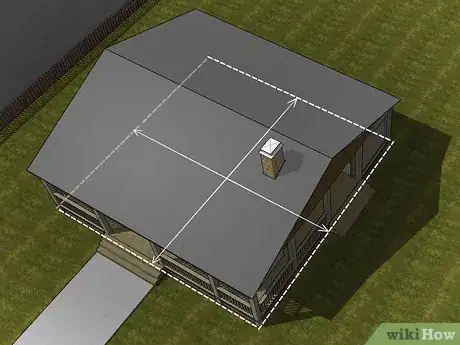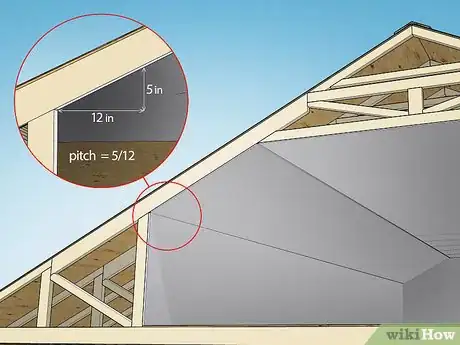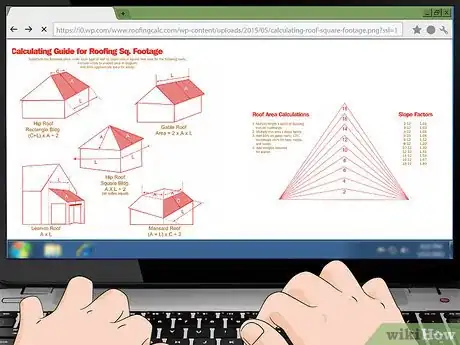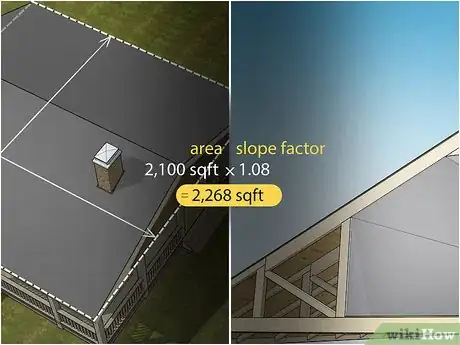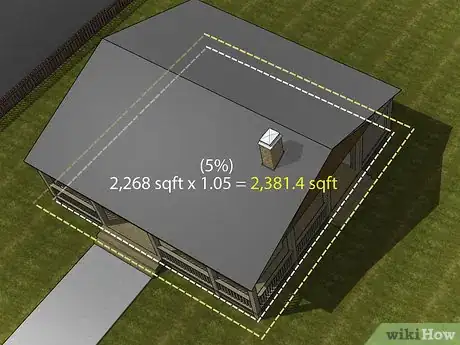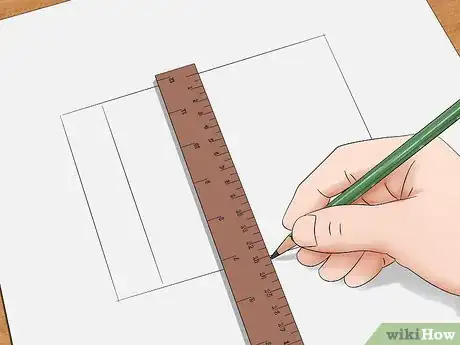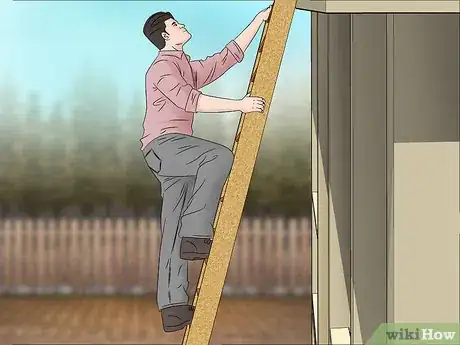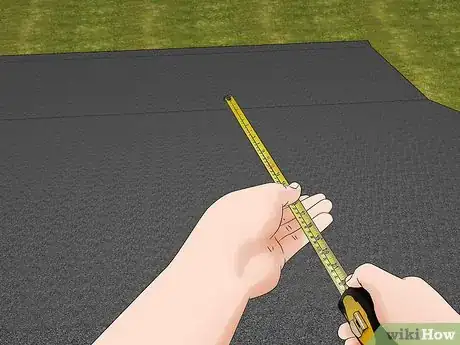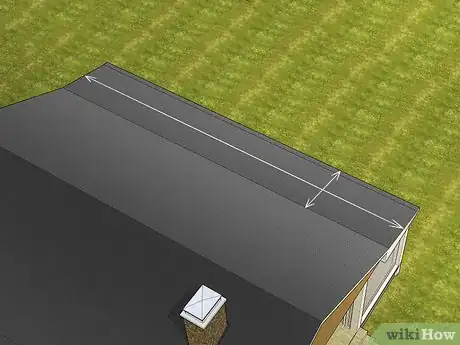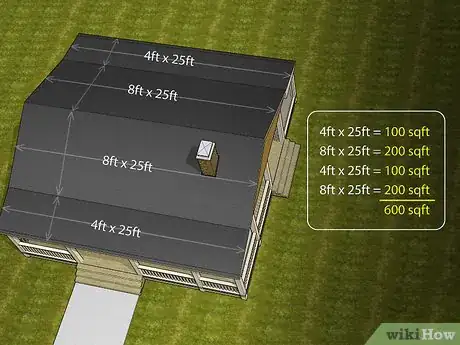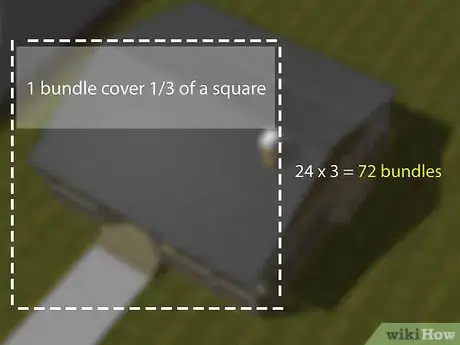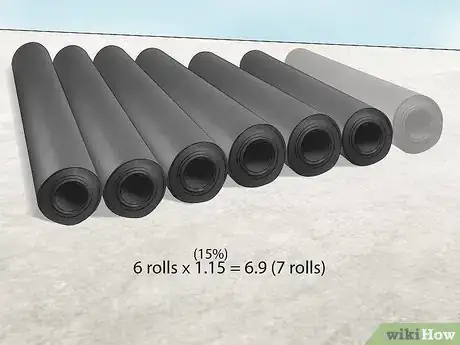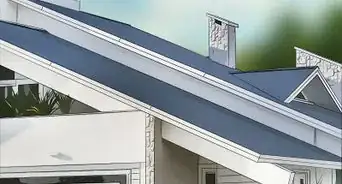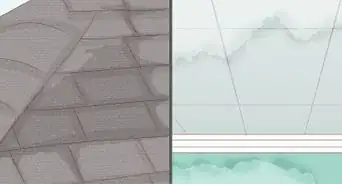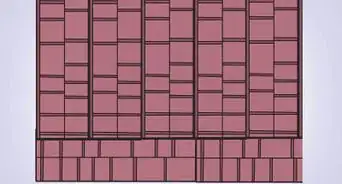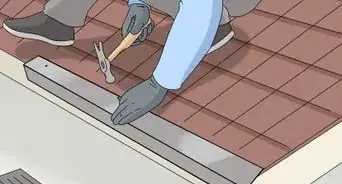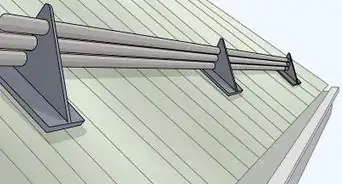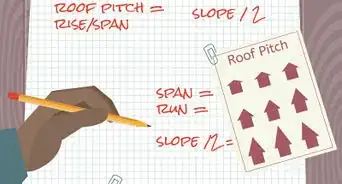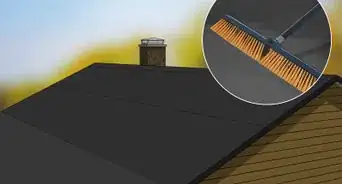This article was co-authored by David Bitan. David Bitan is a roofing professional, licensed contractor, and the owner and founder of Bumble Roofing based in Southern California. With over 12 years of construction industry experience, David specializes in restoring, repairing, and maintaining residential, commercial, and industrial roofs. With over 60 years of combined experience, Bumble Roofing provides easy, friendly services to structures including residential, commercial, industrial, multi-family, and government buildings along with hospitals, hotels, and churches.
There are 12 references cited in this article, which can be found at the bottom of the page.
This article has been viewed 93,991 times.
Measuring the area of your roof isn't the simplest process. Obviously, you want to stay safe while still getting a close estimate. One way to get an estimate is to take the square footage or meterage of the building and multiply it by the slope factor (pitch) of your roof. You can get a decent estimation this way. For a more accurate measurement, you'll need to get up on the roof and measure each plane. Once you have the area, you can use that number to figure out how many bundles and rolls of roofing material you'll need to buy.
Steps
Calculating the Area from the Building's Square Footage
-
1Find the square footage or square meterage of your home. You'll need this information to estimate the area of your roof. You can find this information online on real estate websites or on your house or building title.[1]
- Keep in mind that this estimation won't include any areas like garages or enclosed patios that the roof covers. You may need to measure these rooms by hand to figure out the area.
- To figure out the area of a square or rectangular room, measure length and width and multiply them together to get the area. Add that to your square footage total.
-
2Measure the pitch of your roof in the attic. Mark a length of 1 foot (0.30 m) on a long level, starting from one end. Hold the end you measured from against the bottom of a rafter so it's sticking straight out horizontally and is level. From the 1 ft (0.30 m) spot you marked on the level, measure upward to the rafter. The number is the first part of the pitch, while "12 inches" is the second part of the pitch. So if you measured a "5" going up, the pitch is 5/12, or 5 inches every 1 foot.[2]
- You're basically making a triangle. The level and measuring tape will make a right angle, while the rafter will be the hypotenuse of the triangle.
- Most roofing calculators will accept this measurement as is, such as 5/12.
- The pitch is important because it increases the area of the roof by stretching out the height.
Advertisement -
3Find the slope factor. The simplest way to find the slope factor is to look it up on a chart. Use the ratio you found to pick out the appropriate slope factor. For instance, this site has a chart of slope factors, and you can pick the correct one based on the measurements you took: https://www.roofingcalc.com/how-to-measure-and-estimate-a-roof-like-a-pro/.
- For example, the slope factor for 5/12 is 1.08.
-
4Multiply the area of your building by the slope factor. Multiplying the area by the slope factor will help you calculate how much the slope increases the area. Of course, this number is just an estimation for your total roof area.[3]
- So, for instance, if the building is 2,100 square feet (200 m2) and your slope factor is 1.08, multiply them together to get 2,268 square feet (210.7 m2).
-
5Increase your estimation by at least 5%. This area doesn't account for any overhang or any differences in roof pitch.[4] Rounding your total area up will help account for some of these discrepancies, though measuring it by hand will be more accurate.[5]
- Multiply your total area by 1.05 to increase it by 5%. For instance, multiply 2,268 square feet (210.7 m2) by 1.05 to get 2,381.4 square feet (221.24 m2).
Measuring the Length and Width of Each Plane by Hand
-
1Draw an overhead view of your roof. Each area on the roof is a single plane, which just means it's a surface with a 2D shape, like a rectangle or square. Add lines where the different planes come together. Make sure to include all the planes, as well as any shingled sides of dormers your roof may have.
- You don't have to draw this to scale. You just need a basic drawing of what your roof looks like.
- Draw the roof like flat planes. Don't try to add perspective for the pitch. So if you have 2 rectangles meeting together at an angle, just draw 2 rectangles with a line in between.
-
2Climb a ladder with a notepad, a pencil, and a measuring tape. Stow these items in a shoulder or hip pack while climbing for easy access. Wear closed-toe shoes with good grip and avoid working on wet or windy days.[6]
- Use a sturdy extension ladder and prop it against the side of the roof. Make sure the ground is level underneath; if it's not, use plywood to even it out by placing pieces under one side. Tie the ladder to stakes to steady it on the ground, and then tie it with wire to a 20d nail driven into the roof.
- To step onto the roof, hold on to the ladder extending above the base of the roof with 2 hands. It should extend at least 3 feet (0.91 m) from the base of the roof.
-
3Stand at the peak to feed the measuring tape down the length. Plant your feet on one side of the roof and lay the measuring tape down the other side. Feed it down the roof until the bottom hits the edge of the roof. Line the end of the measuring tape up with the base of the roof and lay the other end of the tape measure flat against the top of the roof. [7]
- Read the measurement and write it down on the small map you made of the roof, putting the measurements on the correct sides as you do.
- Always be careful to balance yourself while you're making measurements.
-
4Measure the width of the roof moving from one side to the other. Feed the tape measure out to one edge of the plane you just measured. Run it along the roof as far as it will go. If it doesn't reach all the way, mark the spot where it ends and measure from that spot to the other edge. Add the measurements together if you need to. Write down the measurement for the width of the roof.[8]
- You will need to walk along the roof to get this measurement so be careful.
- If the roof is wider at the base then it is at the top, get a measurement for both the top edge and bottom edge.
-
5Repeat the process for each plane on the roof.[9] You will need measurements for all of them so you can add the areas together to get the total area for the roof. Keep in mind that planes that look the same may actually be slightly different.
-
6Calculate the area of each plane. The simplest planes are rectangles, where you multiply the height times the width.[10] So if a plane is 12 feet (3.7 m) by 18 feet (5.5 m), multiply the 2 numbers together to get 216 square feet (20.1 m2). That's the area of one rectangular plane.[11]
- To get the area of a trapezoid, where the lower edge is longer than the top edge, use the formula [(B1 + B2) x height] / 2. If the top of the plane is 12 feet (3.7 m), the bottom of the plane is 16 feet (4.9 m), and the height is 8 feet (2.4 m), it would look like this: [(12 + 16) x 8] / 2 = 112 square feet or [(3.7 + 4.9)] x 2.4] / 2 = 21.756 square meters.[12]
- If you have other shapes, such as triangles, use the formula for that shape to find the area. For instance, the area of a triangle is base times height divided by 2. The base is the bottom edge of the roof, while the height is what you measure from the base to the top of the triangle in a straight, perpendicular line from the bottom edge of the roof. So if the base is 5 feet (1.5 m) and the height is 4 feet (1.2 m), then you're equation would look like this: [5 feet (1.5 m) x 4 feet (1.2 m)] / 2 = 10 square feet (0.93 m2).
-
7Add the areas from each plane together. Once you figure out the area for each plane, it's simply a matter of adding up all the numbers to one big total. The final measurement will be in square feet or square meters.[13]
- So if you have areas of 216 square feet (20.1 m2), 216 square feet (20.1 m2), 112 square feet (10.4 m2), 140 square feet (13 m2), 240 square feet (22 m2), and 250 square feet (23 m2), add them all together to get 1,174 square feet (109.1 m2).
Calculating How Many Shingles You'll Need
-
1Convert the area into roofing squares, the measurement used for materials. In roofing terms, a "square" is 100 square feet (9.3 meters). Therefore, divide your total area by 100 (or 9.3 if you're using meters) to get the number of squares.[14]
- So, for instance, if your total is 2,381 square feet, that's approximately 23.8 squares or 24 squares, rounded up.
- You can also use an app or a roofing calculator to decide how many shingles you'll need.
- If you're in a country other than the U.S., check the size of roofing bundles in your area before making this calculation, as they can vary from country to country.
-
2Determine the number of shingle bundles you'll need by multiplying by 3. Shingles typically come in a bundle that's large enough to cover 1/3 of a square. To figure out how many bundles you'll need, multiply the number of squares by 3.[15]
- So if you have 24 squares, multiply that by 3 to get 72 bundles.
-
3Figure out the amount of roofing felt you'll need by dividing by 2 or 4. Felt is what goes under the shingles. If you're buying 15-pound felt, 1 roll will be enough for 4 squares. If you're buying 30-pound felt, 1 roll will be enough for 2 squares. Divide your squares by one of these numbers to get the number of rolls you'll need, depending on the thickness of felt you want.[16]
- If you're trying to cover 24 squares, divide by 4 for a 15-pound roll to get 6 rolls.
- If you're trying to cover 24 squares with a 30-pound roll, divide by 2 to get 12 rolls.
-
4Increase these numbers by 15% to account for waste. Multiply the number of rolls by 1.15 to find out the total you need, then round up the nearest whole number. For instance, multiply 6 by 1.15 to get 6.9 rolls (7 rolls) or multiply 12 by 1.1.5 to get 13.8 rolls (14 rolls). That way, you won't run out if you make a mistake or have excess waste.[17]
Expert Q&A
-
QuestionHow do you measure your roof?
 David BitanDavid Bitan is a roofing professional, licensed contractor, and the owner and founder of Bumble Roofing based in Southern California. With over 12 years of construction industry experience, David specializes in restoring, repairing, and maintaining residential, commercial, and industrial roofs. With over 60 years of combined experience, Bumble Roofing provides easy, friendly services to structures including residential, commercial, industrial, multi-family, and government buildings along with hospitals, hotels, and churches.
David BitanDavid Bitan is a roofing professional, licensed contractor, and the owner and founder of Bumble Roofing based in Southern California. With over 12 years of construction industry experience, David specializes in restoring, repairing, and maintaining residential, commercial, and industrial roofs. With over 60 years of combined experience, Bumble Roofing provides easy, friendly services to structures including residential, commercial, industrial, multi-family, and government buildings along with hospitals, hotels, and churches.
Roofing Contractor & Maintenance Professional For the most accurate measurement, all you need to do is measure the length and width of a roof panel and multiply the numbers together to find the area.
For the most accurate measurement, all you need to do is measure the length and width of a roof panel and multiply the numbers together to find the area.
Things You'll Need
- Level
- Measuring tape
- Paper
- Pencil
- Extension ladder, optional
- Hip or shoulder pouch
References
- ↑ https://www.calculator.net/roofing-calculator.html
- ↑ https://www.thisoldhouse.com/ideas/determining-roof-pitch
- ↑ https://www.roofingcalc.com/how-to-measure-and-estimate-a-roof-like-a-pro/
- ↑ David Bitan. Roofing Contractor & Maintenance Professional. Expert Interview. 14 July 2020.
- ↑ https://www.roofingcalc.com/how-to-measure-and-estimate-a-roof-like-a-pro/
- ↑ https://www.familyhandyman.com/tools/how-to-properly-use-a-roof-safety-harness/view-all/
- ↑ https://www.youtube.com/watch?v=ePOxsHl0N0I&feature=youtu.be&t=17
- ↑ https://www.youtube.com/watch?v=ePOxsHl0N0I&feature=youtu.be&t=40
- ↑ David Bitan. Roofing Contractor & Maintenance Professional. Expert Interview. 14 July 2020.
- ↑ David Bitan. Roofing Contractor & Maintenance Professional. Expert Interview. 14 July 2020.
- ↑ https://www.youtube.com/watch?v=qoyN-eQi5zw&feature=youtu.be&t=137
- ↑ https://www.youtube.com/watch?v=qoyN-eQi5zw&feature=youtu.be&t=197
- ↑ https://www.youtube.com/watch?v=qoyN-eQi5zw&feature=youtu.be&t=463
- ↑ https://www.roofingcalc.com/how-to-measure-and-estimate-a-roof-like-a-pro/
- ↑ https://www.bhg.com/home-improvement/exteriors/roofs/roofing-materials-calculator/
- ↑ https://www.bhg.com/home-improvement/exteriors/roofs/roofing-materials-calculator/
- ↑ https://www.bhg.com/home-improvement/exteriors/roofs/roofing-materials-calculator/
About This Article
To measure for roofing shingles, start by calculating the area of each plane, or section, of the roof. Next, divide your total area by 100 to calculate the number of roofing squares you'll need to buy. Then, multiply that number by 3 to figure out how many shingle bundles that amounts to, since shingles typically come in a bundle that's large enough to cover 1/3 of a square. Finally, increase the total by 15% to account for any waste. For tips on measuring the square footage of a building, read on!
